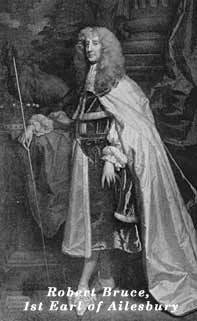Lord Kinloss facts for kids
Lord Kinloss is a special noble title in Scotland. It's part of the Peerage of Scotland, which is a system of noble ranks. This title was first created in 1602 for a man named Edward Bruce. He later became a very important judge called the Master of the Rolls.
When the title was created, it was set up so that his "heirs and assigns whatsoever" could inherit it. This means anyone he chose could be his heir. Later, in 1604, he received another title, Lord Bruce of Kinloss, but this one could only be passed down to his male heirs. In 1608, he got yet another Lord Bruce of Kinloss title, which could go to any of his heirs.
Edward Bruce's son became the second Lord Kinloss. Sadly, he died in a duel in 1613.
Contents
History of the Title
Early Lords and New Titles
Edward Bruce's younger brother became the third Lord Kinloss. In 1633, he was given two new titles: Earl of Elgin and another Lord Bruce of Kinloss. These titles were meant for his male heirs who carried the Bruce family name. In 1641, he also received a title in the Peerage of England, called Baron Bruce.
His son became the second Earl of Elgin. He also received more English titles in 1664, including Baron Bruce of Skelton, Viscount Bruce, and Earl of Ailesbury.
Changes in Inheritance
The fourth Earl of Elgin was the last male descendant of the first Lord Kinloss. He didn't have any sons to pass his titles to. So, he chose his nephew, Thomas Brudenell, as his heir. In 1746, Thomas was given the title Baron Bruce of Tottenham.
When the fourth Earl died in 1747, some of his titles ended because there were no more direct heirs. These included the Earldom of Ailesbury and some of the Bruce baronies. The other titles went to different family lines. The three Lord Kinloss titles and the Earldom of Elgin went to a distant relative, the ninth Earl of Kincardine. The new Baron Bruce of Tottenham title went to his nephew Thomas.
The Kinloss Title's Journey
For a while, it wasn't clear who should be the Lord Kinloss. But in 1868, a special group in the House of Lords (a part of the British Parliament) decided. They said that James Brydges, 3rd Duke of Chandos, was the rightful heir. He was the son of Lady Mary Bruce, who was the daughter of the fourth Earl of Elgin. However, he never actually used the title. When he died, his dukedom ended.
The next heir to the Lordship of Kinloss was his only child, Anne. She was the Duchess of Buckingham and Chandos and was considered the eighth Lady Kinloss by right, even if not officially recognized yet. Her husband was Richard Temple-Grenville, 1st Duke of Buckingham and Chandos.
In 1868, Anne's grandson, Richard Temple-Grenville, 3rd Duke of Buckingham and Chandos, proved his right to the title. He became the tenth Lord Kinloss. When he died in 1889, his dukedom also ended. But the Lordship of Kinloss passed to his oldest daughter, Mary.
As of 2017, the title is held by the thirteenth Lady Kinloss, Teresa Mary Nugent Freeman-Grenville. She inherited it from her mother in 2012.
The family's main home is North View House, which is near Sheriff Hutton in North Yorkshire, England.
Lords Kinloss (1602)
- Edward Bruce, 1st Lord Kinloss (1548–1611)
- Edward Bruce, 2nd Lord Kinloss (1594–1613)
- Thomas Bruce, 1st Earl of Elgin, 3rd Lord Kinloss (1599–1663)
- Robert Bruce, 2nd Earl of Elgin, 1st Earl of Ailesbury, 4th Lord Kinloss (1627–1685)
- Thomas Bruce, 3rd Earl of Elgin, 2nd Earl of Ailesbury, 5th Lord Kinloss (1656–1741)
- Charles Bruce, 4th Earl of Elgin, 6th Lord Kinloss (1682–1747)
- James Brydges, 3rd Duke of Chandos, de jure 7th Lord Kinloss (1731–1789)
- Anne Elizabeth Temple-Nugent-Brydges-Chandos-Grenville, de jure 8th Lady Kinloss (1779–1836)
- Richard Plantagenet Temple-Nugent-Brydges-Chandos-Grenville, 2nd Duke of Buckingham and Chandos, de jure 9th Lord Kinloss (1797–1861)
- Richard Plantagenet Campbell Temple-Nugent-Brydges-Chandos-Grenville, 3rd Duke of Buckingham and Chandos, 10th Lord Kinloss (1823–1889)
- Mary Morgan-Grenville, 11th Lady Kinloss (1852–1944)
- (Beatrice) Mary Grenville Freeman-Grenville, 12th Lady Kinloss (1922–2012)
- Teresa Mary Nugent Freeman-Grenville, 13th Lady Kinloss (b. 1957)
The heir presumptive is the current Lady Kinloss's sister, the Hon. Hester Josephine Anne Freeman-Grenville. An "heir presumptive" is someone who is currently next in line, but could be replaced if a closer heir is born. She was born in 1960. Her heir apparent is her son Joseph Anthony Haworth. An "heir apparent" is someone who is definitely next in line and cannot be replaced. He was born in 1985. His heir apparent is his son, Angus Christopher Temple-Nugent Bridges Chandos Haworth, born in 2018.
| Earls and Marquesses of Ailesbury, Earls of Cardigan, Earls of Elgin, and Earls of Kincardine family tree | |||||||||||||||||||||||||||||||||||||||||||||||||||||||||||||||||||||||||||||||||||||||||||||||||||||||||||||||||||||||||||||||||||||||||||||||||||||||||||||||||||||||||||||||||||||||||||||||||||||||||||||||||||||||||||||||||||||||||||||||||||||||||||||||||||||||||||||||||||||||||||||||||||||||||||||||||||||||||||||||||||||||||||||||||||||||||||||||||||||||||||||||||||||||||||||||||||||||||||||||||||||||||||||||||||||||||||||||||||||||||||||||||||||||||||||||||||||||||||||||||||||||||||||||||||||||||||||||||||||||||||||||||||||||||||||||||||||||||||||||||||||||||||||||||||||||||||||||||||||||||||||||||||||||||||||||||||||||||||||||||||||||||||||||||||||||||||||||||||||||||||||||||||||||||||||||||||||||||||||||||||||||||||||||||||||||||||||||||||||||||||||||||||||||||||||||||||||||||||||||||||||||||||||||||||||||||||||||||||||||||||||||||||||||||||||||||||||||||||||||||||||||||||||||||||||||||||||||||||||||||||||||||||||||||||||||||||||||||||||||||||||||||||||||||||||||||||||||||||||||
|---|---|---|---|---|---|---|---|---|---|---|---|---|---|---|---|---|---|---|---|---|---|---|---|---|---|---|---|---|---|---|---|---|---|---|---|---|---|---|---|---|---|---|---|---|---|---|---|---|---|---|---|---|---|---|---|---|---|---|---|---|---|---|---|---|---|---|---|---|---|---|---|---|---|---|---|---|---|---|---|---|---|---|---|---|---|---|---|---|---|---|---|---|---|---|---|---|---|---|---|---|---|---|---|---|---|---|---|---|---|---|---|---|---|---|---|---|---|---|---|---|---|---|---|---|---|---|---|---|---|---|---|---|---|---|---|---|---|---|---|---|---|---|---|---|---|---|---|---|---|---|---|---|---|---|---|---|---|---|---|---|---|---|---|---|---|---|---|---|---|---|---|---|---|---|---|---|---|---|---|---|---|---|---|---|---|---|---|---|---|---|---|---|---|---|---|---|---|---|---|---|---|---|---|---|---|---|---|---|---|---|---|---|---|---|---|---|---|---|---|---|---|---|---|---|---|---|---|---|---|---|---|---|---|---|---|---|---|---|---|---|---|---|---|---|---|---|---|---|---|---|---|---|---|---|---|---|---|---|---|---|---|---|---|---|---|---|---|---|---|---|---|---|---|---|---|---|---|---|---|---|---|---|---|---|---|---|---|---|---|---|---|---|---|---|---|---|---|---|---|---|---|---|---|---|---|---|---|---|---|---|---|---|---|---|---|---|---|---|---|---|---|---|---|---|---|---|---|---|---|---|---|---|---|---|---|---|---|---|---|---|---|---|---|---|---|---|---|---|---|---|---|---|---|---|---|---|---|---|---|---|---|---|---|---|---|---|---|---|---|---|---|---|---|---|---|---|---|---|---|---|---|---|---|---|---|---|---|---|---|---|---|---|---|---|---|---|---|---|---|---|---|---|---|---|---|---|---|---|---|---|---|---|---|---|---|---|---|---|---|---|---|---|---|---|---|---|---|---|---|---|---|---|---|---|---|---|---|---|---|---|---|---|---|---|---|---|---|---|---|---|---|---|---|---|---|---|---|---|---|---|---|---|---|---|---|---|---|---|---|---|---|---|---|---|---|---|---|---|---|---|---|---|---|---|---|---|---|---|---|---|---|---|---|---|---|---|---|---|---|---|---|---|---|---|---|---|---|---|---|---|---|---|---|---|---|---|---|---|---|---|---|---|---|---|---|---|---|---|---|---|---|---|---|---|---|---|---|---|---|---|---|---|---|---|---|---|---|---|---|---|---|---|---|---|---|---|---|---|---|---|---|---|---|---|---|---|---|---|---|---|---|---|---|---|---|---|---|---|---|---|---|---|---|---|---|---|---|---|---|---|---|---|---|---|---|---|---|---|---|---|---|---|---|---|---|---|---|---|---|---|---|---|---|---|---|---|---|---|---|---|---|---|---|---|---|---|---|---|---|---|---|---|---|---|---|---|---|---|---|---|---|---|---|---|---|---|---|---|---|---|---|---|---|---|---|---|---|---|---|---|---|---|---|---|---|---|---|---|---|---|---|---|---|---|---|---|---|---|---|---|---|---|---|---|---|---|---|---|---|---|---|---|---|---|---|---|---|---|---|---|---|---|---|---|---|---|---|---|---|---|---|---|---|---|---|---|---|---|---|---|---|---|---|---|---|---|---|---|---|---|---|---|---|---|---|---|---|---|---|---|---|---|---|---|---|---|---|---|---|---|---|---|---|---|---|---|---|---|---|---|---|---|---|---|---|---|---|---|---|---|---|---|---|---|---|---|---|---|---|---|---|---|---|---|---|---|---|---|---|---|---|---|---|---|---|---|---|---|---|---|---|---|---|---|---|---|---|---|---|---|---|---|---|---|---|---|---|---|---|---|---|---|---|---|---|---|---|---|---|---|---|---|---|---|---|---|---|---|---|---|---|---|---|---|---|---|---|---|---|---|---|---|---|---|---|---|---|---|---|---|---|---|---|---|---|---|---|---|---|---|---|---|---|---|---|---|---|---|---|---|---|---|---|---|---|---|---|---|---|---|---|---|---|---|---|---|---|---|---|---|---|---|---|---|---|---|---|---|---|---|---|---|---|---|---|---|---|---|---|---|---|---|---|---|---|---|---|---|---|---|---|---|---|---|---|---|---|---|---|---|---|---|---|---|---|---|---|---|---|---|---|---|---|---|---|---|---|---|---|---|---|---|---|---|---|---|---|---|---|---|---|---|---|---|---|---|---|---|---|---|---|---|---|---|---|---|---|---|---|---|---|---|---|---|---|---|---|---|---|
|
|||||||||||||||||||||||||||||||||||||||||||||||||||||||||||||||||||||||||||||||||||||||||||||||||||||||||||||||||||||||||||||||||||||||||||||||||||||||||||||||||||||||||||||||||||||||||||||||||||||||||||||||||||||||||||||||||||||||||||||||||||||||||||||||||||||||||||||||||||||||||||||||||||||||||||||||||||||||||||||||||||||||||||||||||||||||||||||||||||||||||||||||||||||||||||||||||||||||||||||||||||||||||||||||||||||||||||||||||||||||||||||||||||||||||||||||||||||||||||||||||||||||||||||||||||||||||||||||||||||||||||||||||||||||||||||||||||||||||||||||||||||||||||||||||||||||||||||||||||||||||||||||||||||||||||||||||||||||||||||||||||||||||||||||||||||||||||||||||||||||||||||||||||||||||||||||||||||||||||||||||||||||||||||||||||||||||||||||||||||||||||||||||||||||||||||||||||||||||||||||||||||||||||||||||||||||||||||||||||||||||||||||||||||||||||||||||||||||||||||||||||||||||||||||||||||||||||||||||||||||||||||||||||||||||||||||||||||||||||||||||||||||||||||||||||||||||||||||||||||||
See also
- Earl of Elgin
- Earl of Kincardine
- Marquess of Ailesbury
- Duke of Chandos
- Duke of Buckingham and Chandos


